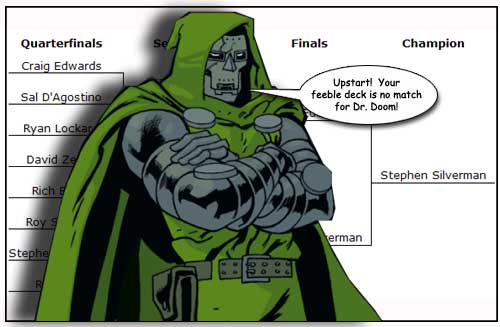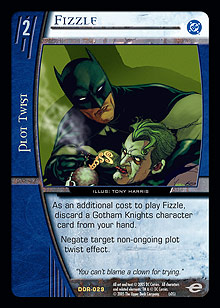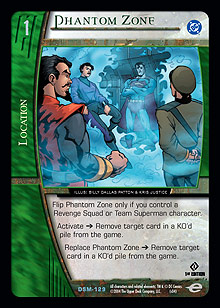
Any of you who have read the DC Identity Crisis storyline know that Dr. Light has a history of being a very naughty boy. In Golden Age thus far,
Dr. Light, Arthur Light has done more than his fair share of stunning, not to mention the havoc he's caused when opponents failed to end the game before turn 9.
With
Green Lantern Corps and
Dr. Light, Master of Holograms, though, there is a whole new branch of naughtiness for players everywhere to contend with. Craig Edwards and Stephen Silverman were wrecking balls at
$10K Philadelphia with their versions of the single most obscene combo deck to hit the
Vs. System thus far. They each tore through the Swiss and their respective halves of the brackets in a show that surpassed the efforts of Dean Sohnle and Richard Edbury at $10K Amsterdam to break out a new deck in dominating fashion.
There is still some contention as to the exact name of this rather vicious creation, and while the most commonly-used seems to be Light Show, my personal favorite is Evil Medical Bill. When doctors come into play for this deck, you know you are going to pay . . .
Here are the two lists:
Stephen Silverman
Characters
Locations
Plot Twists
Craig Edwards
Characters
4 Henry King Jr. Brainwave
Plot Twists
These are the sort of decks that keep me awake at night. The combo is not the most straightforward on paper, but it is brutally powerful and efficient to the point that it has changed the game as we know it beyond recognition.

The basic (and I use the word basic very loosely here) combination is as follows. Dr. Light can be exhausted at any time to return a character from one's KO'd pile to play. If he does so to return
Rama-Tut to play, then all plot twists in the KO'd pile become fair targets to be returned to one's hand. If the plot twist returned is
Cosmic Radiation, then Dr. Light is all ready to work his magic again, assuming that he has magically been made a member of the Fantastic Four. The final essential piece of the combo is
Devil's Due. This ongoing plot twist serves a neat double duty. It provides a way to put
Rama-Tut back into the KO'd pile to get plucked back out by Dr. Light, and it provides a win condition by making a Dr. Doom character arbitrarily large when the loop of returning
Rama-Tut and
Cosmic Radiation gets going. Throw in
Gone But Not Forgotten to gain arbitrarily high amounts of endurance and
Valeria Richards to draw one's entire deck, and this really is the combo to end all combos . . . and the game.
Clearly, there are quite a lot of elements involved in winning with this combination: a team-up between Emerald Enemies and Fantastic Four, a
Devil's Due, a Dr. Light, a
Rama-Tut, a
Cosmic Radiation, and another Doom character (so that there is a target for
Devil's Due). One way or another, you also need to control Dr. Doom so that
Rama-Tut gets to do his thing. It is easy to see why the deck wasn't being played by more people, as historically, combos involving that many elements aren't exactly the most reliable. However, as the deck is aiming to win on turn 3 or 4, there is ample room left from not needing to play high drop characters to fill up with ways of ensuring that the pieces come together on time. These ways include some incredible synergies.
Both versions of the deck have an artificially high number of team-ups, with Edwards running nine plus a
Lacuna and Silverman running eight plus an extra copy of the 2-drop that can help to find them. Personally, I'm a bigger fan of the Edwards build of the deck because I like the idea of being able to use the card drawing elements of extra copies of the team-ups you draw to dig for more combo pieces. The relative resilience of having
Metropolis and
Marvel Team-Up to protect against ongoing plot twist hate is fair enough, but I'm a bit of a gambler and would rather beat decks running hate with speed than by diversifying my team-ups.
There are a variety of search effects in both decks that are used to fetch assorted combo pieces, but my absolute favorite has to be
Signal Flare. Already one of the greatest character-fetching plot twists ever devised,
Signal Flare becomes completely absurd when its additional cost of discarding a Fantastic Four character is negated by the ability of Dr. Light. When Dr. Light immediately puts the fetched character into play after it's been discarded to
Signal Flare, opponents had better watch out. Who knew that the good doctor had a bit of a thing for phosphorous flares?
The Ring Has Chosen performs a similar role, getting
Rama-Tut into the KO'd pile even if a team-up hasn't yet been found.
In reality, there aren't many elements of the combo that are hard to assemble using whichever pieces have already been drawn. Dr. Light makes all the character search effects that much more powerful, and any
Cosmic Radiations drawn can be used early to power out more characters with Dr. Light or card drawing with
Valeria Richards or
Millennium without fear.
Rama-Tut will always be able to return the important plot twist should it be used early. There is a certain amount of calculation required to go off, though—playing combination decks requires a somewhat different modus operandi than playing control or beatdown.
The critical turn for Light Show is turn 4. The turn 3 win is possible and will in some instances be possible and preferable (if there is a distinct chance of problematic resistance coming from an opponent on later turns, as will be discussed later), but in general, the deck is looking to do its full naughtiness on turn 4. This requires significant amounts of planning ahead.
While some elements of playing the deck are draw dependent, given the dizzying number of search effects it runs it is important to have some priorities in terms of what you need when to go off. At the most basic level, having Dr. Light,
Kristoff Von Doom, and
Rama-Tut and being teamed up with Fantastic Four are the only character concerns immediately required for going off. Dr. Light in effect affords 1 additional resource point each turn, so the onus could be on finding him. In actuality, the Fantastic Four character and subsequent team-up might be a more important search in the very early game, as
Signal Flare becomes more and more threatening with each team-up and
Valeria Richards is the ideal character with which to draw into combo pieces. There are enough team-ups that drawing into them shouldn't be dramatically hard, so
Boris will often be better off going for
Devil's Due (as his is the only search effect that can find it) than a team-up. Extra team-ups can be fetched through the chain of a character search effect and
Lacuna, making them really quite abundant.
The absolutely terrifying reality of the Light Show deck is that it is devastatingly fast, and with virtually every card in the deck being either a redundant combo piece or a card that helps to find one, it is disconcertingly consistent. How does one fight such a creation?
The coverage of the finals at
$10K Philadelphia showcased the most immediate answer to a doctor with high fees;
Dr. Doom, Diabolic Genius clearly doesn't like the idea of being usurped as the most devastating doctor around and his ability is sufficient to completely shut down the combination. He puts a huge clock on the combo player to win before his polished mask becomes visible in play. Silverman's higher “scary doctor count” was assuredly the reason for his victory in the mirror, and anyone running a deck such as New School or
Common Enemy has a very real chance of making players of this combination deck just as sad as
Rigged Elections players (including Craig Edwards again . . . beginning to see a pattern here?) were in the past when they saw a 4-drop Doom.

There are few other cards that say no to the arbitrarily large loop of Light Show as decisively as
Dr. Doom, Diabolic Genius does. The most generic answer would be to use ongoing plot twist removal to break things up. The first word of warning here, though, is that if most of the pieces appear to be in play, it is probably too late.
Devil's Due, for example, will often not be flipped up until the combo player is winning the game right then and there. The loop itself can be repeated in response to any effects being put on the chain, so trying to take out this ongoing plot twist will likely be doomed to failure. Hitting team-ups as early as possible is generally the way to go.

For decks running Gotham Knights,
Fizzle is a great answer to
Cosmic Radiation, and will force the use of the powerful space rays earlier in order to sneak activated abilities through. Sentinels' own
Sentinel Mark II can work similar tricks in the negation of abilities from any number of characters in Light Show, but unfortunately, the plot twist negation is not available to them. The higher the turn count, the more this becomes an issue, as if EMB is allowed to assemble a critical mass of combo pieces, it can punch through the resistance and go off with relative ease. So, Sentinels must look to beat down while locking down their opponent's options. Conveniently, they have access to
Overload and
Search and Destroy with which to do this, so while things are nowhere close to good for the big robots, they can at least mount a token defense.
These direct stun options are also available to Teen Titans, the other major archetype that is rightly afraid of what happens when their enemy Dr. Light teams up with both the Fantastic Four and Dr. Doom. With
Finishing Move in the mix, the Teen Titans have a little bit of leeway to slow things down, and their primary target should likely be Dr. Light himself unless all elements of the combo are in place except the 3-drop win condition.
Terra and Roy Harper do good work here, with
Foiled! or
Have a Blast! and
Overload each being key cards, as well.

A more rogue inclusion which gives the deck trouble is
Phantom Zone, available to both Team Superman and the Revenge Squad. It can make life very tricky for EMB if one waits for the moment that the deck is trying to go off and steals a
Rama-Tut from the KO'd pile in response to Dr. Light's activation. The power of
Phantom Zone would very much be contingent on how competitive a deck could be made with either of the
Man of Steel set teams, but given the potential shown by Phantom Phone Booth (which used
Gangbuster to head up an assault on Sentinels), there might be some possibilities there.
For generic ways to fight the combination,
Bad Press could slow it down somewhat. Indeed, Black Cat was a clever choice by Craig Edwards as insurance for protecting his combo in both the mirror and various other matchups. The best it will ever do is slow things down, but when fighting combination decks, that can sometimes be enough.
What is most worrisome to me about Light Show, though, is that even the best answer (
Dr. Doom, Diabolic Genius) may well not prove good enough to stop the deck from winning an alarmingly high amount of the time. For those who just decided to go with super men and women of all shapes and sizes without a doctorate, life looks even bleaker.
There has long been an argument within TCGs about the power of playing the “best deck” compared to that of playing the “answers” in any given format. For PC New York, Sentinels was, as deemed by the majority of players, the best deck. In that instance, most players chose to go for raw power and endeavored to have just enough tech to stymie any decks that wanted to “answer” their immediate threat. Sentinels is nowhere near as immediately powerful as Light Show. The answers to Sentinels weren't as immediately clear as they are in this instance, but they were somewhat more reliable. Barring absurd situations, games would never be over before turn 6 in a Sentinels match, so any clever tech had a reasonable chance of getting online.
Some very clever deckbuilders have laid down a gauntlet to the entire Vs. System community. Dr. Light and his medical team are here and they've brought all the tools of their trade with which to make surgical strikes on the top positions in Golden Age tournaments around the globe. If you are looking to fight them, it seems entirely possible that the best weapon will be one not currently in use. If there was ever a format which rewards forward planning and thinking outside the box to find answers, it is the one that exists now that Light Show has broken out of Philadelphia and begun its run at the entire world. Tech is the key. Much like a game of Gauntlet, it's all about finding the key so that you can go on and fight the next boss, level up, and get a better sword. Okay, it's just about tech. I'm sure you get the idea.
Until next time, have fun, and don't forget your medical insurance!
Tim Willoughby
timwilloughby (at) hotmail (dot) com